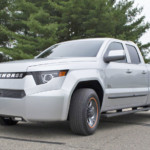 Apple released new MacBook Pros yesterday that feature Intel’s year-old Skylake microarchitcure, as opposed to the newer Kaby Lake architecture. Two days earlier, Microsoft did the same thing when it released the Surface Studio. Given the improvements Kaby Lake processors have over Skylake processors, one would think they would be included in the latest and greatest products from Microsoft and Apple. Gizmodo explains why that’s not the case: In the case of the new 15-inch MacBook the answer is simple. “The Kaby Lake chip doesn’t exist yet, ” an Apple rep told Gizmodo. Kaby Lake is being rolled out relatively slowly, and it’s only available in a few forms and wattages. The 15-inch MacBook Pro uses a quad-core processor that has no Kaby Lake equivalent currently. That particular laptop really does have the fastest processor available. The same goes for the Microsoft Surface Studio and updated Surface Book — both also use a quad-core Skylake processor with no Kaby Lake counterpart. But the Studio and Surface Book are also using much older video cards from the Nvidia 900 series. Nvidia has much faster and less power-hungry chips (the 1000 series) available based on the Pascal architecture. Microsoft’s reasoning for going with older video cards is nearly identical to Apple’s for going with a slower processor in its 13-inch MacBook Pro: the Nvidia 1000 series came out too late. The major intimation was that Kaby Lake and Pascal came so late in the design process that it would have delayed the final products if they’d chosen to use them. New technology, no matter how amazing an upgrade it might be, still requires considerable testing before it can be shipped to consumers. One minor bug, particularly in a system as engineered as the Surface Studio or MacBook Pro, can turn catastrophic if engineers aren’t careful. In the case of Microsoft, it’s frustrating, because that old GPU is significantly slower than the Pascal GPUs available. It’s a little less frustrating in Apple’s case, largely because of the old processor microarchitecture that Apple elected to shove into its new 13-inch MacBook Pro. Apple went with a new Skylake dual core processor that draws a lot of power — more so than any Kaby Lake processor available. It then uses all that extra power to ramp up the speeds of the processor. Which means it is capable of pulling off speeds that can actually match those of the fastest Kaby Lake processor out there. The only downside to this decision is battery life. Read more of this story at Slashdot.
Apple released new MacBook Pros yesterday that feature Intel’s year-old Skylake microarchitcure, as opposed to the newer Kaby Lake architecture. Two days earlier, Microsoft did the same thing when it released the Surface Studio. Given the improvements Kaby Lake processors have over Skylake processors, one would think they would be included in the latest and greatest products from Microsoft and Apple. Gizmodo explains why that’s not the case: In the case of the new 15-inch MacBook the answer is simple. “The Kaby Lake chip doesn’t exist yet, ” an Apple rep told Gizmodo. Kaby Lake is being rolled out relatively slowly, and it’s only available in a few forms and wattages. The 15-inch MacBook Pro uses a quad-core processor that has no Kaby Lake equivalent currently. That particular laptop really does have the fastest processor available. The same goes for the Microsoft Surface Studio and updated Surface Book — both also use a quad-core Skylake processor with no Kaby Lake counterpart. But the Studio and Surface Book are also using much older video cards from the Nvidia 900 series. Nvidia has much faster and less power-hungry chips (the 1000 series) available based on the Pascal architecture. Microsoft’s reasoning for going with older video cards is nearly identical to Apple’s for going with a slower processor in its 13-inch MacBook Pro: the Nvidia 1000 series came out too late. The major intimation was that Kaby Lake and Pascal came so late in the design process that it would have delayed the final products if they’d chosen to use them. New technology, no matter how amazing an upgrade it might be, still requires considerable testing before it can be shipped to consumers. One minor bug, particularly in a system as engineered as the Surface Studio or MacBook Pro, can turn catastrophic if engineers aren’t careful. In the case of Microsoft, it’s frustrating, because that old GPU is significantly slower than the Pascal GPUs available. It’s a little less frustrating in Apple’s case, largely because of the old processor microarchitecture that Apple elected to shove into its new 13-inch MacBook Pro. Apple went with a new Skylake dual core processor that draws a lot of power — more so than any Kaby Lake processor available. It then uses all that extra power to ramp up the speeds of the processor. Which means it is capable of pulling off speeds that can actually match those of the fastest Kaby Lake processor out there. The only downside to this decision is battery life. Read more of this story at Slashdot.
Read the original post:
Why Apple and Microsoft Are Using Last Year’s Skylake Processors In Their New Computers







